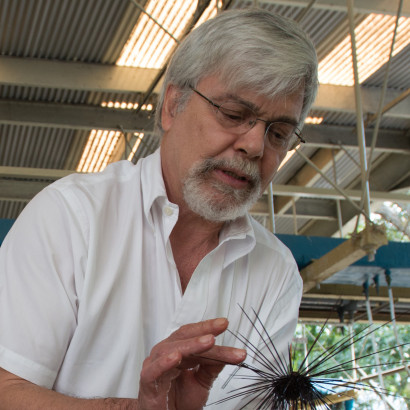There are millions of species in the oceans. How did they come to be? Although we seek general rules, the answer may lie in the detailed biology of each group.
B.A., Harvard College, 1973
M.Phil., Yale University, 1976
Ph.D., Yale University, 1979
H.L. Lessios and G. Hendler. 2022. Mitochondrial phylogeny of the brittle star Genus Ophioderma. Nature Scientific Reports 2022. 12:5304. doi.org/10.1038/s41598-022-08944-0
S.E. Coppard, H. Jessop, H.A. Lessios. 2021. Phylogeography of the sea urchin genus Echinothrix: patterns of dispersal, connectivity, colouration and cryptic speciation across the Indo-Pacific. Nature Scientific Reports 22:26568. doi.org/10.1038/s41598-021-95872-0
T.J. Carrier, H.A. Lessios, A. M. Reitzel. 2020c. Eggs of echinoids separated by the Isthmus of Panama harbor divergent microbiota. Marine Ecology Progress Series. 648:169-177. doi.org/10.3354/meps13424
L. Geyer and H.A. Lessios. 2020b. Slow evolution under purifying selection in the gamete recognition protein bindin of the sea urchin Diadema. Nature Scientific Reports. 10:9834 DOI:101038/s41598-020-66390-2
A. Hiller and H.A. Lessios. 2019d. Marine species formation along the rise of Central America: The anomuran crab Megalobrachium Molecular Ecology 29:413-428. DOI: 10.1111/mec.15323
N. Mongiardino Koch, S. Coppard, H.A. Lessios, D. Briggs, R. Mooi, G. Rouse. 2018b A phylogenomic resolution of the sea urchin tree of life. BMC Evolutionary Biology (2018) 18:189 doi.org/10.1186/s12862-018-1300-4
H. A. Lessios and I. Baums. 2017a. Gene flow in coral reef organisms of the tropical eastern Pacific. In: P.W. Glynn, I.C. Enochs, and D. Manzello (eds.) pp. 477-499 In: Coral Reefs of the Eastern Pacific. Springer-Verlag. DOI: 10.1007/978-94-017-7499-4_16
A. O’Dea, H. A. Lessios, A.G. Coates, R.I. Eytan, L.S. Collins, A.L. Cione, A. de Queiroz, D.W. Farris, R.D. Norris, S.A. Restrepo-Moreno, R.F. Stallard, M.O. Woodburne, O.Aguilera, M.-P. Aubry, W.A. Berggren, A.F. Budd, M.A. Cozzuol, S.E. Coppard, H.Duque-Caro, S.Finnegan, G.M. Gasparini, E.L. Grossman, K.G. Johnson, L.D. Keigwin, N.Knowlton, E.G. Leigh, J.S. Leonard-Pingel, P.B. Marko, N.D. Pyenson, P.G. Rachello-Dolmen, E.Soibelzon, L. Soibelzon, J.A.Todd, G.J. Vermeij, J.B.C. Jackson. 2016c. Formation of the Isthmus of Panama. Science Advances, 2: 8, e1600883. DOI: 10.1126/sciadv.1600883
H. A. Lessios. 2016a. The great Diadema antillarum die-off: 30 years later. Annual Review of Marine Science 8:267-283 doi:10.1146/annurev-marine-122414-033857
H. A. Lessios, S. Lockhart, R. Collin, G. Sotil, P. Sanchez-Jerez, K. S. Zigler, A. F. Perez, M. J. Garrido, L.B. Geyer, G. Bernardi, V. D. Vacquier, R. Haroun, B.D. Kessing. 2012a. Phylogeography and bindin evolution in Arbacia, a sea urchin genus with an unusual distribution. Molecular Ecology, 21:130-144 DOI:10.1111/j.1365-294X.2011.05303.x
H. A. Lessios. 2011. Speciation genes in free-spawning marine invertebrates. Integrative and Comparative Biology, 51: 456-465


